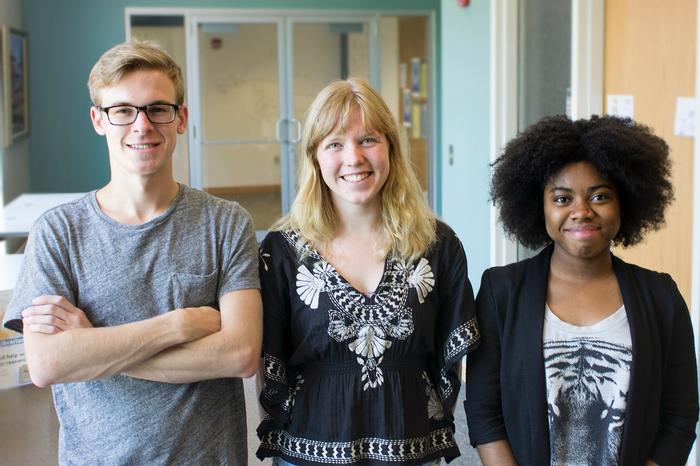
Approaching 501 Park Street in Syracuse, a visitor would see what looks like a Catholic church. Though this site was once home to the Holy Trinity Roman Catholic Church, the building is now being converted into a mosque.
As neighborhood demographics change, the need for specific religious spaces tends to shift as well. This summer, three students are working on a Levitt Group Research Project, “Sacred Spaces in Transition,” under the guidance of Assistant Professor of Art Robert Knight and Visiting Associate Professor of Religious Studies Brent Plate.
The students, Jasmin Thomas ’15, Sawyer Konys ’16 and Shannon Boley ’17 are examining religious spaces in the Second Ward of Utica’s downtown. Like 501 Park Street, the Second Ward is a transitional landscape that is responding to shifting neighborhood demographics. The Second Ward is the city’s immigration hub: first welcoming Welsh religious refugees, then a large influx of Jewish immigrants, followed by Muslims from Bosnia, Thailand, and Somalia, and now accommodating Buddhists from Thailand and Vietnam.
Thomas and Boley are working closely with Plate in order to compile a comprehensive history of the religious spaces of the Second Ward. The two began by studying historical maps of the area, before shifting to primary sources, history books and various archives. They are looking at structural changes to the buildings, including renovations and remodelling, focusing on the motivations behind these changes.
Boley, a prospective religious studies major, is specifically examining the relationship between the ebb and flow of immigrant populations and the boom-and-bust cycle of particular religious spaces. Commenting on the presence of Christianity, she cited the Tabernacle Baptist Church, stating: “Utica, in particular, was in decline but now they’re being bolstered by the immigrant communities.”
Boley is a member of Hamilton’s All Beliefs Union and a part of an interfaith group in Utica; “the interviews are really why I’m doing this,” she revealed. “By making connections with people of different religious backgrounds, you get a more global understanding about what the world is like,” she added. Boley admitted that she “never thought about how important language is to a religion,” but now sees the intersection of identity and culture with spirituality.
Certainly, not only sanctioned spaces are considered sacred, a theme Thomas contemplated during her independent study with Plate in the spring. Although a building may have once been considered sacred for Christians, it may now house Muslims or Buddhists. Thomas, a religious studies and art double major, is specifically examining how architecture influences religious practices. She explained that she wants to note how people move within the space. Citing Utica’s St. Matthew's Baptist Church as an example, Thomas noted that the main aisle is roped off because the congregation dances there.
Thomas made clear that she is studying all sorts of religions through her major, not just sects of Christianity; a common misconception about the department. “It’s a big world out there, with a lot of religions and different spiritualities,” Thomas stated. She is conducting interviews at three places of worship, and will also be collecting data from students as to what they consider sacred spaces, or sacred in general.
Konys, a studio art major on a pre-med track, is working with Knight on the aesthetic angle of the project. Konys helps Knight with on-site filming and audio recording, but is also conducting an independent photo series of religious spaces in transition. In Syracuse’s old German neighborhood, Konys is photographing the former Holy Trinity Roman Catholic Church, which is currently being renovated into a mosque for 4,000 Thai and Somali refugees.
This is Konys’ first time exploring religious spaces, especially in non-European traditions, like Islam and Buddhism. Growing up in a secular household, he was somewhat surprised to find that “some people are still very devout, and religion is constantly shaping the world around you.” Konys is glad Knight approached him about joining the research team, saying the experience has been a truly influential one for him.
After college, Boley is interested in pursuing interfaith work to “increase religious literacy in our society in order to create more holistic citizens, bringing groups together for common goals.” Similarly, Thomas is dedicated to social justice; she plans to work with a non-profit organization to continue serving community members in the Bronx, where she was born and raised. Konys also intends to make a positive difference in people’s lives by using modeling and 3D printing for reconstructive plastic surgery.
Whether it’s a Bosnian mosque turned Methodist church, or an Israeli synagogue converted to a Buddhist temple, sacred spaces are not in danger of death; rather they are always being reincarnated as one place of worship or another. A prime example of the “American melting pot,” Utica only becomes more diverse and continues to welcome refugees and immigrants with open arms.
Jasmin Thomas is a graduate of the Bronx Center for Science and Mathematics.
Sawyer Konys graduated from Manlius Pebble Hill School in Syracuse, N.Y.
Shannon Boley is a graduate of Westfield High School, Mass.
